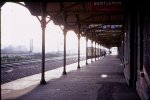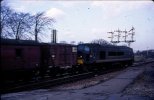Interesting...I have a fleeting memory of Trent station and it is exactly comparable to
@Merle Haggard's first picture. Travelling to Scotland on the Thames-Clyde Express in October 1965 and I remember my father pointing it out, pretty certain that the train didn't stop but must have been going slowly enough for it to imprint on my memory.
I have tried to spot the site on the rare occasions that I have passed by, I hope to be going that way again shortly...what should I look out for?
If you are on Leicester or Derby to Nottm service you can not miss it as you pass by the large former Power Signal Box which is on the south side of the tracks
weirdly I can not good a good picture link but it's v similar in style, size and colour to the image here of Derby PSB - half way down page
The history of railway signalling around Derby, UK

www.derby-signalling.org.uk
The MR cottages, I assume for staff at Trent station etc - are beside the PSB in a row and also can not be missed as your train passes.
Trent station was about 300 meters west of the current PSB building. I don't think you can see any trace of the former station - at least not from a passing train.
If you are heading north from Leicester after East Mids Parkway station (to Derby) you go through Redhill Tunnel then almost immediately over the Trent. You would have to look east towards Nottm as the Nottm tracks curve away towards where Trent would have been and you can probably still see the PSB from there, you then soon pass Sheet Stores Jct where on the west of the line you can see the former MR wagon sheet stores buddings, in private industrial use but good condition with distinctive railway style cast metal window frames in the walls.
If you look at an online Ord Survey map you can see the area quite easily. Even better if you c an access the Nat Lib Scotland OS maps of the area and overlay the old maps from that to see the complexity of lines in the area south of Toton Yards.
There are also occasional trains (IIRC a Sunday morning Nottm Leeds service) that is routed for driver knowledge through some of the part of Trent Jct that lead north towards Long Eaton town and Toton Yards that are not used by many passenger trains these days
A trip to Nottm by train is the best way to see the remaining infrastructure of tracks and junctions that are still there at Trent - which is quite a bit of it.


